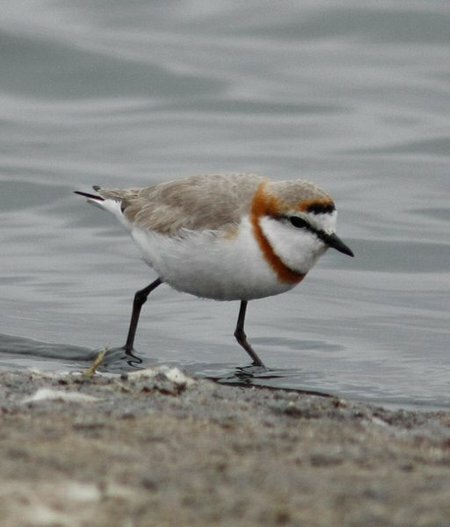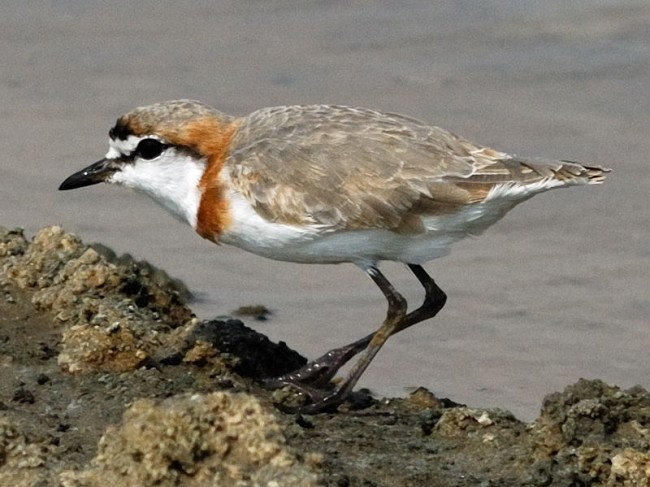Chestnut-banded Plover
Fahl Plover ( Charadrius pallidus ), Fahl Plover, male in breeding plumage, Mile 4 salt works, Swakopmund, Namibia
The Fahl Plover ( Charadrius pallidus ) is a small seabird of the family of plovers. He lives in southern and eastern Africa, where it has a very disjoint distribution area.
Description
The right- legged Fahl plover is composed of around 15 centimeters in length slightly smaller than a White-fronted plover (Charadrius marginatus ). The wing length is 100-105 mm, the weight is just under 40 grams.
It is the smallest member of the genus Charadrius, its top is very pale gray, white below with a narrow chestnut band on the breast, which is scaled slightly black in the male birds. It differs from the White-fronted Plover by the smaller size, more rounded physique, a gekrümmtere attitude, a paler back, the chestnut breast band and the lack of white wing bars in flight.
Juveniles are drawn in black on the head, her chest band is gray, often incomplete or absent. Chicks are forward light gray, slightly mottled with black, irregular lines, their underside is white.
Dissemination
The Fahl plover is found in southern and eastern Africa, where it occurs throughout the year in some areas and only occurs seasonally in different regions. Main distribution areas are the coasts of the Atlantic and Indian Oceans, the Makgadikgadi salt pans in Botswana's interior, in the west of the Transvaal and the Orange Free State, in the northwest of the Cape Province and in the Etosha Pan. Less common it is at Sabi River (to the east of the Transvaal / Kruger National Park), at the confluence of Sashi and Limpopo (southern Botswana, Northern Transvaal ), in the area around Bulawayo ( Central Zimbabwe) and Victoria Falls on the Zambezi, and along the coast of the Indian Ocean in Mozambique from Maputo ( Lourenço Marques ) up to the Zambezi.
Wetlands International is one of the internationally most renowned areas with deposits of Fahl plover the lagoon south of the town of Walvis Bay in Namibia, the Lake Magadi in Kenya, Lake Natron and Lake Manyara in Tanzania.
Habitat and way of life
The Fahl plover lives in salt water and sandy lagoons, salt and brackish water pans, salt pans and seasonal fluctuations in estuaries.
He lives singly or in pairs and comes outside the breeding season in flocks up to 50 birds before. Its behavior is similar to that of the White-fronted Plover, but he is shy and very vigilant, especially when nesting. If it is disturbed, he flees at low altitude, on the white salt flats, he is standing still difficult to detect.
He is frequently in the company of White-fronted plovers - (Charadrius marginatus ), dwarf beach runners (Calidris minuta ) and sickle beach runners (Calidris ferruginea ) to watch. It feeds on insects, which he pecks from the ground or from the mud and water searches. The Fahl plover belongs beside the shepherds plover of the few species that occur throughout the year and thus also during the dry season in the area of the Makgadikgadi salt pans.
Reproduction
The breeding season depends on the local conditions and is used mainly in the winter months from March to September. The Fahl plover builds on exposed salt flats and beaches simple nests with six to seven centimeters in diameter and about 1.5 inches deep, lined with shells, small stones, feathers and dry plant residues.
The nest consists usually of two eggs, which are pale - brown and spotted dark brown - gray. The period of incubation and the time until the young birds have fledged, is not yet precisely known. To the business of breeding and rearing of chicks to take care of both parents.
Designation
The common name in English Chestnut -banded Plover indicates the maroon breast band.










